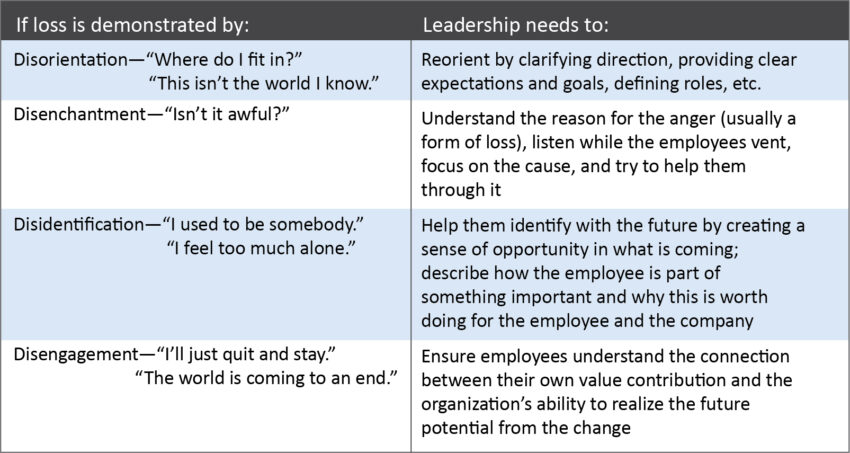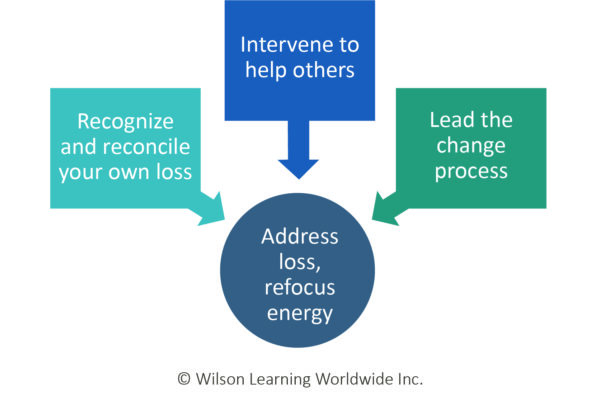A 3-Step Process for Leading in Times of Change
In order to successfully move through organizational change, leaders must first reflect on their own situation and deal with their own concerns as leaders first. Then, and only then, can leaders influence, mentor, and compassionately support others as they move through change.
Building your and your employees’ resilience involves three critical steps:
1. Recognize and reconcile your own loss. Change is often perceived as a loss—and the uncertainty occurring in the world today is resulting in the loss of economic stability, status, friendships, identity, authority, tradition, purpose, and more. The moment change happens, energy disperses. The natural tendency is to immediately retreat within and think about “What does this mean for me?” However, everyone responds to loss differently in what we call the 4-Dis’s:
- Disorientation—“Where do I fit in?” “This isn’t the world I know.”
- Discontent—“Isn’t it awful?”
- Disidentification—“I used to be somebody.” “I feel too much alone.”
- Disengagement—“I will just quit and stay.” “The world is coming to an end.”
To be resilient, the first step is to recognize what’s happening, deal with your perceived loss, and resolve the loss within yourself. You can then make a choice to move forward in the context of opportunity, focusing your energy toward innovation and what value and success looks like in the new tomorrow.
 2. Intervene to help others. Just as you felt a sense of loss by what you told yourself about this loss, so do your employees. As the change happened, they too responded to loss, and their Dis might be different than yours.
2. Intervene to help others. Just as you felt a sense of loss by what you told yourself about this loss, so do your employees. As the change happened, they too responded to loss, and their Dis might be different than yours.
Employees may not tell you that they are struggling with the change. Our experience in training leaders to tune in to what employees are saying or doing better equips them to help manage energy dispersed by the employee’s perception of the disrupting situation. Leaders need to be proactive and recognize the clues employees are sending, and then intervene to help them recognize and reconcile their loss at their own pace, as we all move through change at varying speeds. Your communication strategies will change as you operate in a virtual environment. Proactively communicating through video can be an effective way to acknowledge what you do and don’t know, continue to build trust, and show transparency.
There is nothing traditional about this change and using traditional change management step-wise progression to “push” people through change won’t work. Change was pushed out at an alarming velocity to the world. Resilience is proactively intervening to help others move through change, at their pace, for recognizing perceived loss and choosing how they will commit their energy to the change.

3. Lead the change process. The problem with most reactive forms of change management is their focus on countering the negatives of change, countering people’s thoughts about whether they or the organization will survive the change, or concerns over the losses.
Resilience is less about countering the old negative story and more about creating the new story, embedded in the context of realistic opportunity. It’s refocusing your and your employees’ energy on “what is our potential for growth, sustainability, or collaboration going forward?” It is not about what we have lost in this change but what we gain that needs to be told.
Skillfully Leading Forward from This New Place
If you look at resilience as a wave, you allow the troubles to pass through you, change you, and then deal with the loss that is happening to you as a leader. If you then understand the Dis’s and your role in intervening with your now virtual team, you can lead the change process by keeping the mindset of “what is our potential?” as the framework for everything you do and who you are as a leader.
1 Deloitte Insights, The heart of resilient leadership: Responding to COVID-19,
https://www2.deloitte.com/us/en/insights/economy/covid-19/heart-of-resilient-leadership-responding-to-covid-19.html


 2. Intervene to help others. Just as you felt a sense of loss by what you told yourself about this loss, so do your employees. As the change happened, they too responded to loss, and their Dis might be different than yours.
2. Intervene to help others. Just as you felt a sense of loss by what you told yourself about this loss, so do your employees. As the change happened, they too responded to loss, and their Dis might be different than yours.